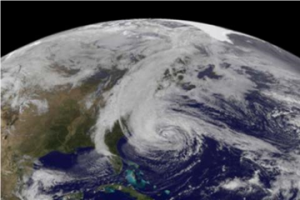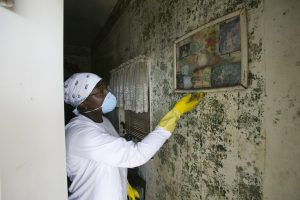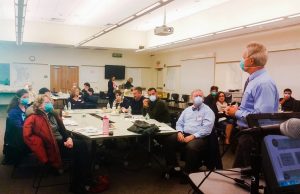Hurricane Sandy: Mold Exposure and Health-Related Training

Principal investigator, Paula Schenck, M.P.H., Center for Indoor Environments and Health
Many responded to the devastation of Hurricane Sandy: union and non-union construction, trade and maintenance/public works employees; public health and environmental professionals; emergency response including medical personnel; volunteers - students, faith-based and/or community organizations; and family members and friends of property owners. Exposure to molds and associated bioaerosols in the damp environments of damaged homes and buildings is a risk to breathing health and respiratory illness.
Background: Mold Exposure and Health
Moisture in the indoor environment is directly associated with adverse respiratory health effects (Mendell et al. 2011, Heseltine and Jerome 2009, IOM 2004). Some reports go beyond symptom outcomes and suggest that exposures in moldy workplaces increase the risk of developing asthma (Nevalainen and Seuri 2005, Karvala et al. 2011). Intervening on mold and moisture indoors provides an opportunity to improve symptoms, possibly prevent asthma initiation, and address a contributing factor to the disparity in respiratory disease (US asthma prevalence increases with decreasing economic status from 6.4% (richest Americans) to 10.3% (those at or below poverty levels) (Moorman et al 2007).
Severe weather events bring attention to threats of respiratory illness associated with moisture incursion and indoor exposures. The Institute of Medicine Committee on the “Effect of Climate Change on Indoor Air Quality and Public Health” identified chemical exposures, vector-borne disease, and mold and moisture associated illnesses as potential impacts from the damage and degradation of buildings, flooding and water damage associated with hurricanes (IOM 2011).
The Northeastern United States experienced a series of catastrophic weather events over the last few years: excessive snow and ice (2011 winter); Tropical Storm Irene (2011 summer); a snow event in the fall, Storm Alfred (2011) that resulted in (as much as) two weeks of power outages; and Hurricane Sandy which caused extensive destruction (2012 fall). Documented consequences include carbon monoxide poisoning (Styles et al. 2012) and mental health impacts (Neria and Schultz 2012).

Response and recovery workers without proper protection may encounter substantial exposure to bioaerosols and dust. Concerns over cough and respiratory disease from prolonged exposure to conditions post hurricane flooding surfaced after Hurricane Katrina with the widespread damage and extensive flood waters. A cross-sectional study of a Katrina worker group representing maintenance, construction trades and homeowners reported that transient fever and dry cough, and new onset sinusitis correlated with time in renovation activities. New asthma onset was also noted, but as not statistically significant (Rando et al. 2012). There are many limitations to self-reported symptom surveys with limited exposure measures; however the correlation of symptoms with floodwater contact and renovation activity supports imposing actions that mitigate exposure to dusts and mold. The news reports of a similar non-productive “Sandy Cough” among recovery workers and clouds of dust (9 news reports) lend strength to the argument that wearing proper masks is an appropriate worker health and safety action. Individuals representing union and volunteer workers provided anecdotal reports of their experience post Sandy hurricane and specifically noted training and adequate personal protective equipment needs at the “Safe and Effective Flood and Mold Remediation-After the Super Storm Sandy “ specialty conference held in March 2013 (Johanning et al. 2013).
Although there is technical guidance and training materials available on what people need to do to protect themselves, many do not know how to find it and some choose not to follow the advice. In addition the scientific information about mold exposure and restoring our hurricane damaged places is not always clear and understandable.
The Recovery from Catastrophic Weather Project

The Center for Indoor Environments and Health at UConn Health has begun a project to provide guidance on working safely and protecting your health when responding to hurricanes and/or rebuilding water damaged property. (The effort is supported by a cooperative agreement 1U01OH010627-01 from the Centers for Disease Control and Prevention’s National Institute for Occupational Safety and Health (NIOSH). This description is solely the responsibility of the authors and does not necessarily represent the official views of NIOSH.)
The project design will engage representatives of the diverse worker, volunteer and homeowner populations impacted by Hurricane Sandy in Connecticut to investigate the barriers to their using methods and appropriate Personal Protective Equipment (PPE) in emergency response and recovery efforts; review available training materials and develop additional resources in response to the identified barriers; make the material accessible through web publications, personal electronic devices, implement seminars designed to overcome barriers; and will disseminate the information throughout the Sandy states. Completion of the work will serve as a model for use broadly in preparedness efforts that are designed to respond to hurricanes and other catastrophic weather events.
Hypothesis
Workers, volunteers, and homeowners who have knowledge about health consequences related to bioaerosol exposures during and after hurricane events, will utilize appropriate methods and PPE during restoration and rebuilding activities.
Research Questions
- What are the barriers to workers, volunteers and homeowners using appropriate methods and protective equipment to reduce health risks from moisture and mold exposure when responding to hurricane events?
- Are current risk messages about mold exposure and health adequate? What are the major information gaps about health effects of mold and moisture among?
- Professional workers from multiple types of workers,
- Agency personnel,
- Volunteers, homeowners, public,
- Health providers and emergency medical personnel
Project Aims
- To identify barriers through structured focus groups and other qualitative approaches to Hurricane Sandy emergency response and recovery workers a) becoming knowledgeable about mold exposure health risks and b) acting appropriately on the knowledge “pre-, during, and post-response and recovery activities”.
- To create a risk communication strategy/messaging around mold health effects targeted to union and non-union construction, trade, and municipal workers; and faith-based and other community groups who would likely be involved in hurricane response and recovery.
- To implement a training program in Connecticut that overcomes identified barriers for worker groups through web-based and seminar encounters.
- To develop and integrate a course segment on mold exposure/health effects for emergency medical/health care personnel into the UConn Center for Indoor Environments and Health online clinicians course, and renew the Continuing Medical Education offering.
- To make technical guidance accessible via personal devices to increase overall use at point of response and recovery action.
- To disseminate technical resources that have been evaluated and piloted in Connecticut to all Hurricane Sandy states.
Summary of Public Health Significance
Recovery from catastrophic weather brings threats and opportunities to public health. Mold exposure and related respiratory illness are unintended consequences to unprepared response and recovery personnel. With greater knowledge about mold’s relationship to health and with better skills in addressing flood-damaged properties, the well-prepared workforce will have increased capacity to protect worker and volunteer populations against illness and to rebuild environments for healthier, more resilient communities able to withstand the next hurricane.
For overall information regarding the project contact Paula Schenck, M.P.H., principal investigator, at 860.679.2368 or schenck@uchc.edu.
References
Heseltine, E.R., Jerome, ed. WHO guidelines for indoor air quality : dampness and mould 2009, World Health Organization: Copenhagen. 248.
IOM, Climate Change, the Indoor Environment, and Health. 2011, Institute of Medicine of the National Academies: Washington, DC. 320 pages.
IOM, Damp Indoor Spaces and Health. 2004 Institute of Medicine of the National Academies: Washington, DC. 356 pages.
Johanning E, Auger P, Morey PR, Yang CS, Olmsted E. Review of health hazards and prevention measures for response and recovery workers and volunteers after natural disasters, flooding, and water damage: mold and dampness. Environ Health Prev Med. 2014 Mar;19(2):93-9. doi: 10.1007/s12199-013-0368-0. Epub 2013 Nov 20
Karvala K, Toskala E, Luukkonen R, Uitti J, Lappalainen S, Nordman H. Prolonged exposure to damp and moldy workplaces and new- onset asthma. Int Arch Occup Environ Health. 2011 Oct;84(7):713-21. doi:10.1007/s00420-011-0677-9. Epub 2011 Jul 19.
Mendell, M.J., et al., Respiratory and allergic health effects of dampness, mold, and dampness-related agents: a review of the epidemiologic evidence. Environ Health Perspect, 2011. 119(6): p. 748-56.
Moorman JE, Rudd RA, Johnson CA, King M, Minor P, Bailey C, et al.; National surveillance for asthma -- United States,1980- 2004. Centers for Disease Control and Prevention (CDC).MMWR Surveill Summ. 2007 Oct 19;56(8):1-54.
Neria Y, Shultz JM..Mental health effects of Hurricane Sandy: characteristics, potential aftermath, and response. JAMA. 2012 Dec 26;308(24):2571-2.
Nevalainen A, Seuri M. Of microbes and men. Indoor Air. 2005;15 Suppl 9:58-64.
Rando RJ, Lefante JJ, Freyder LM, Jones RN. Respiratory health effects associated with restoration work in post-Hurricane Katrina New Orleans. Environ Public Health. 2012;2012:462478. doi: 10.1155/2012/462478. Epub 2012 Dec 9.
Styles T, Przysiecki P,Archambault G.,Toal B.,Sosa L. Carbon Monoxide Poisoning Outbreak Following a Rare October Snowstorm - Connecticut, 2011. Connecticut Epidemiologist Connecticut Department of Public Health March 2012.